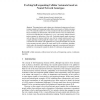49 search results - page 7 / 10 » Learning Robot-Environment Interaction Using Echo State Netw... |
HUC
2010
Springer
13 years 6 months ago
2010
Springer
Even though the coordination of kids’ activities is largely successful, the modern dual income family still regularly experiences breakdowns in their practices. Families often r...
IWSOS
2011
Springer
12 years 10 months ago
2011
Springer
Abstract This paper depicts and evaluates an evolutionary design process for generating a complex self-organizing multicellular system based on Cellular Automata (CA). We extend th...
CVPR
2009
IEEE
15 years 2 months ago
2009
IEEE
We address the problem of label assignment in computer
vision: given a novel 3-D or 2-D scene, we wish to assign a
unique label to every site (voxel, pixel, superpixel, etc.). To...
JMLR
2008
13 years 7 months ago
2008
Many complex control problems require sophisticated solutions that are not amenable to traditional controller design. Not only is it difficult to model real world systems, but oft...
ICAC
2007
IEEE
14 years 1 months ago
2007
IEEE
— Reactive systems are those that maintain an ongoing interaction with their environment at a speed dictated by the latter. Examples of such systems include web servers, network ...

